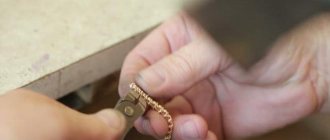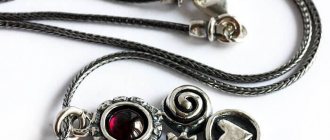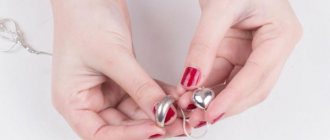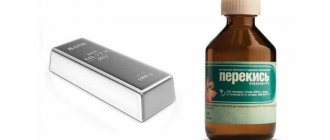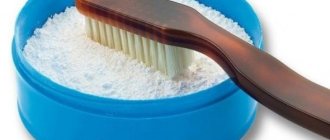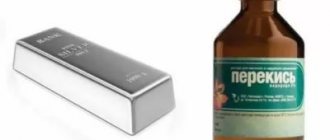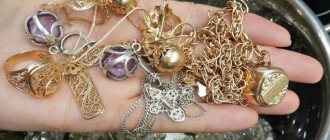Once upon a time, every wealthy family sought to replenish their cutlery arsenal with silver spoons, forks and knives. “Eating from silver” was considered a sign of high social status, good taste and strong material well-being.
Nowadays, silver appliances are not so popular: they have been replaced by analogues made from materials that are not so expensive and require maintenance - for example, stainless steel. However, some owners still purchase status sets of silver or receive them by inheritance. And miniature silver spoons, which are traditionally bought for babies “for their first tooth,” are found in many homes.
It is believed that a silver spoon helps your baby's teeth grow healthy. And this is not a superstition: silver is a natural antiseptic that is destructive to bacteria. Including those that cause caries.
Reasons for darkening of silverware
Silver devices (as well as jewelry) are never made from pure argentum. Silver is a fairly soft metal, and spoons made from it will bend and deform easily. Therefore, alloys (other metals) are added to it, which give silver better performance characteristics. The lower the sample, the higher the content of ligatures.
Silverware turns black mainly due to the reaction of ligatures to aggressive factors: high humidity, cleaning agents, certain substances in food.
Nevertheless, silver itself is also not completely inert. Its worst enemy is sulfur, which is found in our natural excretions, as well as in some foods (for example, onions, garlic, eggs, etc.). The surface layer of silver reacts with sulfur and sulfide is formed - that unsightly dark coating that you would like to get rid of.
See all silver teaspoons in the SUNLIGHT catalog
If you are not choosing silverware from an antique shop, pay attention to rhodium-plated spoons, forks and knives. They are coated with a thin layer of rhodium, which makes the silverware more shiny and protects it from the appearance of a black coating.
Reviews
My silverware is in the sideboard, in a closed box, with velvet inside. It's a nice set, but we've never used it. The color of the metal is still white, even though 10 years have passed since I was given this box.
Zhanna R. g, Stavropol
Liliya G., Moscow
According to my observations, silver loses color under the influence of aggressive substances (concentrated vinegar, other acids). I ruined 1 box of beautiful spoons and knives and forks. Since then I’ve been telling everyone so they don’t repeat my mistakes.
I have been cleaning silverware with chalk for several years now. It always helps, although sometimes there are divorces. I advise you to wash items after cleaning in plenty of water.
Maria P. g, Leningrad
How to clean silverware
It is not recommended to clean and wash silver cutlery (especially without rhodium plating) with conventional dishwashing detergents: they can accelerate the processes of oxidation and sulfidation, that is, the formation of a dark coating.
In modern hardware stores, looking for means for cleaning silverware is almost pointless: there is no demand - no supply. You can try your luck in jewelry stores: they often sell all kinds of sprays and pastes for cleaning silver in all forms. However, they are not cheap, and you definitely won’t find them in small towns (well, unless you are willing to wait for delivery from an online store by mail).
Don’t be sad: cleaning silver from blackness at home is not such a technologically complex process. And the necessary substances will probably be at your fingertips - in extreme cases, you will have to run to a pharmacy, a regular hardware store or a grocery store.
Cupronickel silver is often confused with silver - they are indeed very similar in appearance. Cupronickel was invented as a cheap substitute for silver. It is an alloy of copper and nickel and is widely used in the production of cutlery, jewelry, coins and medical instruments.
So, let's try to quickly and effectively clean silverware without the involvement of jewelry workshops and special tools.
Effective detergents
As mentioned above, in the case of silverware, you cannot use ordinary detergents - they can leave unsightly dark stains. Avoid using abrasives as they will scratch delicate surfaces.
The matter is further complicated by the fact that silverware (especially antique ones) often have intricate decorations. And we’re not just talking about all kinds of curls, reliefs and indentations. Silverware was often decorated with decorative blackening or gilding, and the metal was combined with ivory and precious wood.
Nevertheless, in every home you can find effective and safe means for caring for silverware (including antique silver).
If antique silver has a purely decorative function, it is not necessary to clean it: the noble patina further emphasizes the flair of antiquity and aristocracy. But if you use cutlery for food, it is better to get rid of dark deposits.
Water, soda and foil
This method is very simple and effective. Its only drawback is that it cannot be used for blackened silver, as well as cutlery with elements made of heat-sensitive organics (wood, ivory, and so on). Alloys with low silver content may also suffer.
To clean silverware using this method, you need:
- Line the bottom of the dish with foil. The cookware must be fireproof (pan or tray made of glass, stainless steel or with intact enamel). The most ordinary culinary foil will do.
- Place silver on foil, add water, add baking soda. The amount of water is calculated by eye: the main thing is that it covers the silver by 2-3 fingers. The amount of soda is about a tablespoon per half liter of water.
- Place the container on the fire. You need to bring the contents to a boil, boil for a couple of minutes and leave alone for half an hour. At this time, a chemical reaction will occur, and the soda particles will gently remove the plaque.
- If necessary, clean, rinse with running water and dry. Hard-to-reach places can be treated with cotton swabs or matches wrapped in cotton wool. Finally, you need to rinse the silver under the tap and wipe dry with soft textiles.
It is not recommended to use dry soda to clean silver - it is an abrasive. Do not pick out remaining dirt with sharp metal objects (needle, nail, awl, screwdriver, etc.).
Starch or potato decoction
In this case, only natural ingredients are used. The simplest, but not very effective option is to pour the broth left over after boiling the potatoes into the silverware. There is no need to cool it: the hotter it is, the more effective.
The second way is to use starch as an assistant (ideally corn starch, but potato starch will also work). We proceed like this:
- Prepare starch paste. Just add water to the starch and stir. You should get a paste-like consistency.
- We process silver. Apply the paste to the entire surface and wait for it to dry completely. This takes 15-20 minutes.
- Rub, rinse, dry. When the starch is completely dry, clean the spoons and forks with flannel or terry cloth. After this, wash off the remaining starch, rinse and dry the silver.
You will not get rid of the old blackened layer in this way, but it is quite suitable for regular care.
Chalk polishing
This is an old ancestral method: it was with chalk that hardworking maids polished the silverware of aristocrats to a shine. You can use this time-tested method now.
It's simple: you need to crush the chalk and treat the silver with it using a soft cloth. If desired, the chalk can be slightly moistened until a paste is obtained.
The main problem is to find clean chalk that does not contain solid particles (sand and small pebbles). Otherwise, scratches may appear on the silverware.
Soaking products in salt and water
If you want to clean a silver spoon that you use regularly, you can use a saturated water-salt solution.
The solution is prepared simply: take a container, pour hot water from the tap into it, dissolve table salt in it (more, the main thing is that it dissolves), add silver and leave for about an hour.
See all sets of teaspoons in the SUNLIGHT catalog
If desired, you can even boil silver in a saline solution: if there are no inserts or blackening on the devices, nothing will happen to it, and minor blackening will go away safely.
Washing powder
You shouldn’t rub silver with washing powder: who knows? However, it can be used in another way, for example, in the form of a gruel, with which the product should be rubbed.
The second option is boiling in water with powder. For a better effect, you can line the bottom of the container with foil or wrap each spoon in it.
Do not use regular powders. It’s better to use baby laundry detergent – it’s less aggressive.
Toothpaste and tooth powder
Toothpaste and powder can be used for mechanical cleaning of silver: the chemical effect here is minimal. Simply squeeze the paste onto a soft cloth and rub the product. It is not recommended to use pastes with a whitening effect - they contain abrasives, although they are mild.
Tooth powder is used in the same way, either dry or diluted with water to a paste.
Vinegar based solution
In this case, we are no longer talking about mechanics, but about pure chemistry. Acetic acid is a powerful reagent that can cope with any darkening. But in its pure form it is destructive for the metal itself.
You won’t find acetic acid (essence) in stores: they sell ordinary food vinegar (that is, its aqueous solution in low concentration). You can not only safely soak silver in it, but even boil it. You can dilute it with water in a 1:1 ratio, but this is rather for your own peace of mind.
Soaking in lemon juice
Lemon juice is a pure acid, so it also works well at removing stains. Take half a lemon and rub it on your silver, wait 30-60 minutes and rinse off the juice. If possible, you can soak the silver in pure lemon juice for the same period.
Much more democratic citric acid has a similar effect. The optimal concentration is one standard sachet per half liter of water. You can even boil it.
Silver has turned black - how to clean it at home: useful tips
Silver items are easily exposed to hydrogen sulfide in the air. Please note that hydrogen sulfide compounds are found in many cosmetics.
Silver must be kept clean. Clean it from dust and dirt at least a couple of times a month. This applies to cutlery, dishes, icons, figurines, and jewelry.
Here are some ways to keep your silver items clean:
- If your silver items become dirty from sand, dust or cosmetics, place them in a container of warm water.
- Add a few drops of liquid detergent there and leave them to soak for a couple of hours.
- During this time, the soap solution will penetrate into all hard-to-reach areas
- Next, clean the products with a soft brush. Rinse under running water and dry with a towel
- For the purpose of prevention, as well as removing shallow dirt, ordinary water and baking soda will help you.
- Wet the silver item and sprinkle it with a small amount of baking soda. Take a cotton cloth and rub the product
- A bottle of ammonia (10%) is poured into a small container. Silver jewelry is also placed there.
- It is better to put the ammonia mixture on the balcony or in places where you will not breathe the pungent odor
- The solution with the products is left for a period of half an hour to 3 hours. Then all products are removed and washed under water
- One of the newest methods for prevention in cleaning silver is the use of highly carbonated drinks.
- Typically, Sprite, CocaCola and other fizzy drinks are chosen. A bottle of sparkling water is poured into a saucepan
- Silver utensils and jewelry are placed there. The liquid is brought to a boil, and then all products are removed. Wash with water and dry with a cotton towel
- Window cleaner is great for cleaning all types of silver. A few pumps of the bottle must be sprayed onto the silver object.
- Wait until the chemical begins to eat away the dirt and rub the contaminated areas. After the procedure, rinse the product with water and wipe dry with a towel.
How to Polish Silverware
In addition to cleaning it from dirt, it is customary to polish silver to a mirror shine. The most well-known and accessible means for these purposes is the chalk already mentioned above.
Among the professional, but cheap and time-tested products, we can name the well-known GOI paste. After treatment with it, even shallow scratches disappear from the surface of silver.
Polishing with a soft eraser
If you have schoolchildren or art enthusiasts in your home, you will probably have erasers. Just rub the surface with an eraser and your silverware will shine.
It is best to use classic soft pencil erasers made of rubber. However, in the absence of them, any others will do, the main thing is not too tough.
Polishing silver with lipstick
To polish silver, you can theoretically use any color of lipstick. It's simple: apply lipstick to the surface and rub it vigorously with a cloth.
This method is best used in extreme cases. Firstly, the polishing effect is not so strong, and secondly, then you will be tortured to pick out the lipstick from the recesses.
Which cleaning method to choose
It is best to clean silver with professional chemicals, for example, “Ultra Soft”, “Town walk” spray for small appliances, “Silbo” foam, “Hagerty” solution. But such products are quite expensive, so using them for constant cleaning is simply irrational.
There are many alternative, time-tested methods. But before you choose any specific method for yourself, you should know about some general rules for cleaning such cutlery.
Proper care of silver spoons and other silverware
If your silver spoon has darkened, it means you haven’t spent enough time caring for your valuable cutlery. Above we have listed the most effective ways to keep your silver cutlery in order. It is enough to use them from time to time: once every few months or even a year, especially if you use silverware infrequently.
As part of regular care, silver just needs to be washed properly, and only then, if necessary, radically cleaned and polished.
The best way to wash silverware is as follows:
- Dissolve shavings of laundry or baby soap in hot water.
- Soak cutlery in the solution for about an hour.
- Using a soft sponge, carefully remove any remaining food, rinse, and dry.
How to store silverware
If you are the happy owner of such valuable cutlery, you should take care of their proper storage. Main conditions: dryness, stable room temperature, protection from sunlight.
Silverware sets are usually sold in special boxes with a velvet backing, which are best used for permanent storage. Such cases provide personal compartments for each spoon and fork.
Under no circumstances should silver be lying around in a kitchen drawer mixed with less noble cutlery. If you don’t have a special case or you use a silver spoon all the time, then at least store it separately, wrapped in a cloth.
It is better to leave silver cutlery for special occasions, and for ordinary meals use something less pretentious and capricious. The exception is a children's silver spoon.
Thick soap solution
The primary operation is to wash the silver in a thick soapy solution, preferably using dishwashing detergent. Thus, the fatty film and a lot of other contaminants are removed. For the best effect, especially if there is an ornament or design, engraving, the devices should be soaked in a soap solution at a temperature of about 50°C for half an hour. Afterwards, rinse thoroughly with a sponge. You can use synthetic hard sponges. Only without enthusiasm, even they can scratch soft metal.

